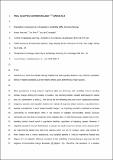Files in this item
Population consequences of migratory variability differ between flyways
Item metadata
| dc.contributor.author | Patchett, Robert | |
| dc.contributor.author | Finch, Tom | |
| dc.contributor.author | Cresswell, Will | |
| dc.date.accessioned | 2019-04-22T23:37:28Z | |
| dc.date.available | 2019-04-22T23:37:28Z | |
| dc.date.issued | 2018-04-23 | |
| dc.identifier | 252481475 | |
| dc.identifier | d47281cb-024b-4254-a870-21fcbc24be5c | |
| dc.identifier | 85045735944 | |
| dc.identifier | 000430694900005 | |
| dc.identifier.citation | Patchett , R , Finch , T & Cresswell , W 2018 , ' Population consequences of migratory variability differ between flyways ' , Current Biology , vol. 28 , no. 8 , pp. R340-R341 . https://doi.org/10.1016/j.cub.2018.03.018 | en |
| dc.identifier.issn | 0960-9822 | |
| dc.identifier.other | ORCID: /0000-0002-4684-7624/work/60426928 | |
| dc.identifier.uri | https://hdl.handle.net/10023/17578 | |
| dc.description.abstract | Long-distance migratory bird populations are likely to be declining because of climate change shifting habitats or anthropogenic habitat loss [1], but this may be mediated by the size of the non-breeding area over which a population spreads (migratory spread), and migration distance (or number of stop-over sites). High migratory spread may make populations more resilient to climate change because they already encompass shifting habitats, but less resilient to uneven habitat loss that may not affect populations with low migratory spread [2] (Figure 1C). As migration distance increases so the probability of encountering a stop-over site with negative environmental change increases [3] (Figure 1D). Consequently, if habitat shift through climate change is the main driver of declines we predict more positive population trends for high spread migrants, but the reverse for outright habitat loss (Figure 1E); we also predict negative population trends for longer distance migrants (Figure 1F). But these relationships may vary between flyways, which differ profoundly in their climate variation, human population change and geography. Here we show that climate change may be more important in Neotropic migrant population declines whereas habitat loss may be more important in the Afro-Palearctic. | |
| dc.format.extent | 549042 | |
| dc.language.iso | eng | |
| dc.relation.ispartof | Current Biology | en |
| dc.subject | QH301 Biology | en |
| dc.subject | NDAS | en |
| dc.subject | BDC | en |
| dc.subject | R2C | en |
| dc.subject | SDG 13 - Climate Action | en |
| dc.subject.lcc | QH301 | en |
| dc.title | Population consequences of migratory variability differ between flyways | en |
| dc.type | Journal article | en |
| dc.contributor.institution | University of St Andrews. School of Biology | en |
| dc.contributor.institution | University of St Andrews. Scottish Oceans Institute | en |
| dc.contributor.institution | University of St Andrews. Institute of Behavioural and Neural Sciences | en |
| dc.contributor.institution | University of St Andrews. St Andrews Sustainability Institute | en |
| dc.contributor.institution | University of St Andrews. Centre for Biological Diversity | en |
| dc.identifier.doi | https://doi.org/10.1016/j.cub.2018.03.018 | |
| dc.description.status | Peer reviewed | en |
| dc.date.embargoedUntil | 2019-04-23 | |
| dc.identifier.url | https://www.sciencedirect.com/science/article/pii/S0960982218303191#app2 | en |
This item appears in the following Collection(s)
Items in the St Andrews Research Repository are protected by copyright, with all rights reserved, unless otherwise indicated.

